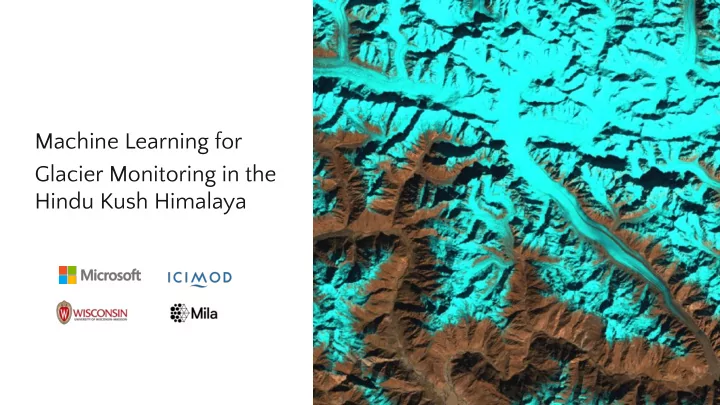

Machine Learning for Glacier Monitoring in the Hindu Kush Himalaya AI for Good Research Lab
Background and Motivation • Glaciers in the Hindu Kush Himalaya (HKH) are ecologically and societally important, and are at risk due to climate change • Monitoring changes is key for water resource and glacial hazard management • The International Centre for Integrated Mountain Development (ICIMOD) curates a Regional Database System to support glacier monitoring of the HKH 2
Current Workflow • Derive spatial data by semi-automatically annotating landsat images - Data are used by scientific and policy communities • Labels are available dating back to 1990 and across the HKH An example of hyperpixel editing in the current labeling workflow. 3
Problem Description • Delineating glaciers is time consuming and challenging to scale • Manual interventions are needed to account for cloud cover, variable snow conditions, and supra-glacial debris Goal: • To effectively demarcate the boundaries of glaciers at different time points • Utilize machine learning to accelerate the mapping workflow 4
Problem Formulation Given a training dataset, semantic segmentation methods learn to assign pixel-level labels Y over input images X X: Cropped Landsat image • 10 channels from Landsat 7 • Add NDVI, NDSI, NDWI • Add SRTM Elevation / Slope Y: Pixel-level glacier labels • Background • Clean ice glacier Debris-covered glacier • Y: Glacier labels X: Input patch 5
Our Approach • Prepare data for modeling • Train semantic segmentation • Use web tool to incorporate feedback 6 6
Challenges and Takeaways: Band Selection • Best performance per subset of bands. • Importance of domain knowledge vs. automatic selection. 7
Challenges and Takeaways: Error Analysis and Debris Discovery • We have compared segmenting glaciers vs. differentiating segmentation of clear ice glaciers and debris-covered ones. • Same overall performance with small amount of debris-covered data. • The gap increases when we have more debris data. (Up to 16% difference when evaluating for area of more than 10% coverage of debris) 8
Challenges and Takeaways: Generalization to New Areas • How is the model is going to work in other geographic areas? • No performance difference is shown when restricting testing geographically. • There study area might be homogenous. 9
10
Glacier Mapping Web Tool
Code & Dataset Code: https://github.com/krisrs1128/glacier_mapping Data: http://lila.science/datasets/hkh-glacier-mapping Microsoft Confidential 12
Next Steps • Formal comparison with semi-automated approach • Use proposed approach for a glacier change analysis 1990 2000 2020 13
Thank you. 14
Recommend
More recommend